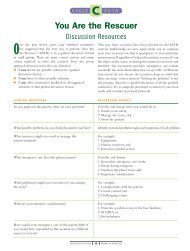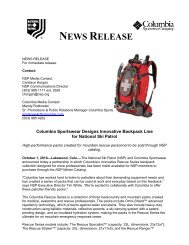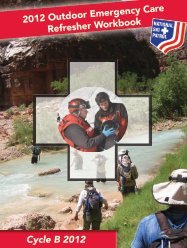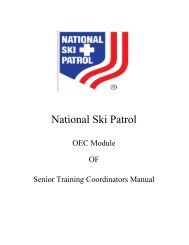You Are The Rescuer Cycle A 2008 - National Ski Patrol
You Are The Rescuer Cycle A 2008 - National Ski Patrol
You Are The Rescuer Cycle A 2008 - National Ski Patrol
- No tags were found...
You also want an ePaper? Increase the reach of your titles
YUMPU automatically turns print PDFs into web optimized ePapers that Google loves.
<strong>You</strong> <strong>Are</strong> the <strong>Rescuer</strong>OEC <strong>Cycle</strong> A <strong>2008</strong>YATR Discussion ResourcesFour scenarios have been selected for the “<strong>You</strong> <strong>Are</strong> the <strong>Rescuer</strong>” (YATR) exercise, oneof which is an invitation for you alone, or with the help of an instructor, to write your own.Regardless of where the incident actually occurred—on a ski slope, in a river or on a hikingtrail—the assessment and basic emergency care remain essentially the same. Each OECtechnician should have read every scenario and formulated an opinion as to his or her proposedactions.Carefully read the scenarios on the following pages. <strong>The</strong>y are based on actual incidents.Using the matrix below, formulate your opinions on the leading questions. Potential discussionpoints have been suggested for each question, but these should not be considered comprehensive.Remember there are many correct answers. “Solving the problem” is not the objective;exploring all possibilities through discussion is. Always consider how these scenarios could differat your particular location and be ready to discuss the possibilities at your refresher course.Leading QuestionsAs you approach this patient,what are your priorities?What possible problems do youthink the patient may have?What resources might you needto manage this patient/situation?What emergency care does thispatient require?Discussion PointsDescribe and discuss what you would do to:• Ensure Scene safety• Manage the scene• Assess the patientIdentify potential problems and the signs and symptoms ofeachFor example:• Equipment• Human resources• Resources needed at baseDescribe and discuss:• Immediate emergency care needsRSG Review Draft 4.0 1 March <strong>2008</strong>
• Needs during transport• In the patrol room• Important considerationsWhat problem(s) might youencounter as you manage thescene?What are your transportconsiderations?For example:• Complications with patient• Crowd control• Challenging terrainFor example:• From the accident scene to the base facilities• 2) ALS / BLS?• 3) Air ambulance?How would your emergencycare of this patient differ had itoccurred in a different season orwhile doing a different activity?Scenario 1It’s a warm morning, and you and your sailing mate are sitting in the cockpit of yoursailboat at anchor in a small, unpopulated harbor. <strong>You</strong> notice a pair of divers approach in theirsmall boat and anchor nearby. <strong>The</strong>y have their dive gear ready to go, and in no time, with theirregulators in their mouths, plunge into the water. Minutes later you notice one of the diversfrantically waving and yelling. Upon closer look you see the female diver has the male by thecollar of his jacket, and you notice something on his head.<strong>You</strong> and your companion grab the first aid kit on board, jump into your dingy and headover. As you get closer, you see that the male diver is bleeding profusely from a large scalpwound, yet he is responsive and thrashing in the water. Upon reaching the divers you find thewoman frustrated, as she is unable to lift him into the boat. Thankfully she has inflated both herjacket and that of her dive partner, so he is buoyant. When you arrive, the male starts to calmdown, though he is still unable to hoist himself into the boat. <strong>You</strong> radio the Coast Guard forassistance, but they are a minimum of 45 minutes away.<strong>The</strong> woman tells you they had turned on their tanks before leaving shore during a buddycheck, but had turned them off for the ride over. It wasn’t until they were descending that theyRSG Review Draft 4.0 2 March <strong>2008</strong>
ealized they had forgotten to turn their tanks back on. Her partner had descended quite quickly,and shot for the surface when he realized his mistake. Failing to look up, he crashed head-firstinto the propeller shaft of the boat’s motor.<strong>The</strong> male starts to shiver. Though the water is calm, the shoreline is rugged and rocky, sothe injured man cannot be transported to shore. <strong>You</strong> are concerned for spinal considerations buthave nothing that can be used as a backboard.Scenario 2It’s an overcast day with temperatures hovering around 20 o F and a cold northern wind at15 mph. <strong>You</strong> receive a report of a downed skier at the top of an intermediate run. <strong>You</strong>’re told thatthe skier is a 55-year-old male paraplegic in a sitski who is complaining of intense pain in his leftshoulder.On approach to the scene you notice a strongly carved track leading past a small group ofbushes. <strong>The</strong> track seemingly ends there, followed by a large, obvious sitzmark in the snow. Onarrival at the scene, you find a skier strapped into a sitski lying on his left side. <strong>The</strong> skier is inobvious pain, but acknowledges your arrival and asks for help. <strong>You</strong> note that the skier appears tobe short of breath, and that his left arm is severely abducted, with a broken outrigger still attachedaround his forearm.<strong>You</strong>r scene size-up concludes that the scene is safe, and you have a single patient. <strong>You</strong>mark the scene and immediately assess the patient’s breathing. At this time, the skier asks you toloosen the strap around his chest, as it is too tight in his present position. On loosening the strap,the skier affirms that he can now breathe more easily. As you continue your assessment, he tellsyou that he caught his outrigger in the brush as he made a turn. His arm, affixed to the outrigger,was pulled away from his body and behind him. He lost control of the equipment as his ski lost itsedge. He heard and felt a “pop” as his arm was pulled away from his body, and then heard asecond “pop” as he slid to a stop. His arm, still strapped into his outrigger, was trapped over hishead.<strong>You</strong>r focused history and physical exam reveals deformity of the left shoulder. <strong>The</strong> skiertells you that he dislocated his right shoulder in a biking accident the previous summer, and that itfelt a lot like this. Vitals are within an expected range, but there is a significant strength deficit inhis left hand. Since loosening the strap around his chest, his respirations are now robust.RSG Review Draft 4.0 3 March <strong>2008</strong>
Scenario 3It’s 20:15 on a clear, breezy night with a temperature of 10 o F when you are called by thetop lift operator, who is reporting an unresponsive skier in the chairlift at the off-ramp. <strong>You</strong> racefrom the patrol facility to the off-ramp and find an approximately 45-year-old male alone in thechair and slumped over the safety bar. He has no detectable breath and no palpable pulse. <strong>The</strong>reare no other patrollers immediately available, and none can reach the scene by skiing from the topof another lift. <strong>The</strong> lift operator states that he completed the pre-season Outdoor First Care coursetaught by the patrol, and about a dozen other untrained guests are nearby.Scenario 4In the past, you’ve been presented with several scenarios for discussion. <strong>You</strong> wereprovided the details of an actual incident and asked to respond to discussion points with fellowrescuers. This year, to challenge you in a slightly different way, we are asking you to write yourown scenario.Here’s how: Think of a specific location at your home area where an accident couldhappen. Keeping in mind the cycle-specific topics for this year’s refresher, imagine a worst-casescenario--literally. What type of incident could happen at this location? Would it be a greatchallenge to you as the first person on scene?Take into consideration the gender, age and physical condition of your patient or patients.What would the weather be like? Would the accident be due to a collision, a fall, a medicalcondition? How much help would you have available? What type of equipment would beavailable or needed? How soon would help arrive?If you would like, draw a stick figure sketch of what the scene would look like upon yourarrival (similar to the photos provided in the YATR scenarios). Describe the condition of yourpatient and what you would expect to find in your assessment. <strong>The</strong>n note how the patient’scondition would change if help was unavailable.Refer to the points for discussion in the other scenarios and apply them to your scenario.Think about the major topics of scene safety, assessment, emergency care (equipment andhelpers), extrication and transportation. Be realistic here and have some fun with it--you neverknow when it might actually happen.RSG Review Draft 4.0 4 March <strong>2008</strong>
Feel free to share and discuss this scenario with your fellow rescuers. Also, ask yourinstructors if they might stage this incident at a future training session or on-the-hill clinic. As analternative, if you would prefer to write up an actual incident for your refresher course thatoccurred at your area, which falls into the topic areas being covered at this years’ content, feelfree to do so. Try to choose one that was challenging for you.RSG Review Draft 4.0 5 March <strong>2008</strong>



